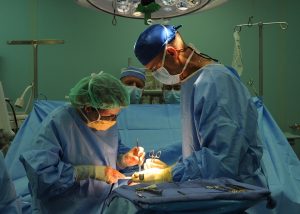
According to the latest statistics, there are 560,800 medical assistants in the United States and what is even better, this number is going to increase to 723,700 by 2022.
The main reason for this increase in medical assistants is the need for more and better healthcare, the growing number of ill and old people, and the increasing number of new open medical facilities.
The expanding healthcare industry is in constant need of well-educated medical assistants and if you wish to become one, now is the right time to start your education towards this career.
A medical assistant, according to the American Association of Medical Assistants (AAMA), is a person who finished formal training and is well equipped with the knowledge needed for working with physicians in medical offices and clinics.
No matter whether they will be in charge of clinical or administrative tasks, medical assistants are a very important part of any medical facility.
They work under the direct guidance and supervision of a physician.
While medical assistants in smaller settings need to handle both administrative and clinical duties of the office, the situation in larger practices is a bit different.
There, it is typical for medical assistants to specialize in a particular area.
Page Navigation
What Do Medical Assistants Do?
Medical assistants are really well trained and educated people who are supposed to help a medical facility runs smoothly and their duties will depend based on the size, location, and practice specialty.
As you may already know, medical assistants can be in charge of administrative, clinical duties, or both, depending on the facility they work in.
When the administrative duties of medical assistants are in question, they may include the following:
- Answering phone calls
- Arranging for hospital admissions and lab services
- Entering and updating patient records
- Filling out insurance forms
- Greeting patients
- Scheduling appointments
On the other hand, there are more demanding clinical duties of medical assistants as well, which may include:
- Assisting doctors during a patient examination
- Authorizing prescription refills
- Changing patient dressings
- Drawing and collecting blood
- Explaining to patients how to use medical treatments and therapies
- Interviewing patients, and writing their medical histories
- Preparing medical therapies and administering them under the direction of a physician
- Preparing patients for examinations
- Serving as a patient liaison
- Taking patient vitals
Where do Medical Assistants Work?
Once you reach a desired level of education, you would probably like to find employment and you can do it in a variety of settings.
However, you can expect that the work of medical assistants is different from facility to facility.
If you find a job in an optometrist’s office, you, as a medical assistant, may be asked to perform diagnostic tests related to the patient’s vision using various testing methods.
On the other hand, finding a job in a gynecologist’s office will require that you prepare patients for gynecological procedures or administer pregnancy tests.
All in all, you can expect to do numerous tasks, and you may work part-time, full-time, evenings, and weekends.
Your main responsibilities will be to work closely with patients and other medical staff.
It is important to be ready to handle several responsibilities at once if you want to be successful in your work.
Some of not so common places where medical assistants can look for employment are:
- Ambulatory healthcare services
- Employment services
- Medical and diagnostic laboratories
- Nursing care facilities
- Outpatient care centers
- Private and public educational services
- State and local government agencies
Education, Training, and Advancement
If you are interested in becoming a medical assistant and you wish to attend formal training from recognized medical assisting programs, we are here to tell you that these programs are offered in a variety of settings.
It is up to you to choose among the following educational facilities:
- Vocational-technical high schools
- Postsecondary vocational schools
- Junior colleges
- Colleges and universities
Medical assistant programs in the U.S. are accredited either by the Commission on Accreditation of Allied Health Education Programs (CAAHEP) or the Accrediting Bureau of Health Education Schools (ABHES).
Currently, there are more than 617 programs accredited by CAAHEP and 358 programs accredited by ABHES.
Also, the Committee on Accreditation for Ophthalmic Medical Personnel accredited an additional 19 programs.
It is true that medical assisting educational programs are not the same in every school or college, but the coursework is definitely very similar, and it covers the following topics:
- Accounting
- Anatomy
- Clinical and diagnostic procedures
- Ethics
- First aid
- Insurance processing
- Laboratory techniques
- Medical administration
- Medical law
- Medical terminology
- Patient relations
- Pharmaceutical principles
- Physiology
- Record keeping
- Typing transcription
If you really wish to be the best in your profession, you should also think about starting an externship.
These are very important educational opportunities for medical assistants, as they are designed to provide students with practical experience.
They can be done in a physician’s office, hospital, or other healthcare facility and students become ready to face the possible situations right after employment.
As you may already know, no state licensing for medical assistants in the U.S. exist, but still a huge number of people decide to get national certifications.
This is due to the fact that many employers of medical assistants require it, as it is proof that medical assistant has met specific standards of competence.
These are recognized professional certifications for medical assistants in the U.S.:
- The American Association of Medical Assistants: Certified Medical Assistant (AAMA) credential
- The American Medical Technologists: Registered Medical Assistant credential
- The American Society of Podiatric Medical Assistants: Podiatric Medical Assistant, Certified (PMAC)
- The Joint Commission on Allied Health Personnel In Ophthalmology: Certified Ophthalmic Assistant (COA)








